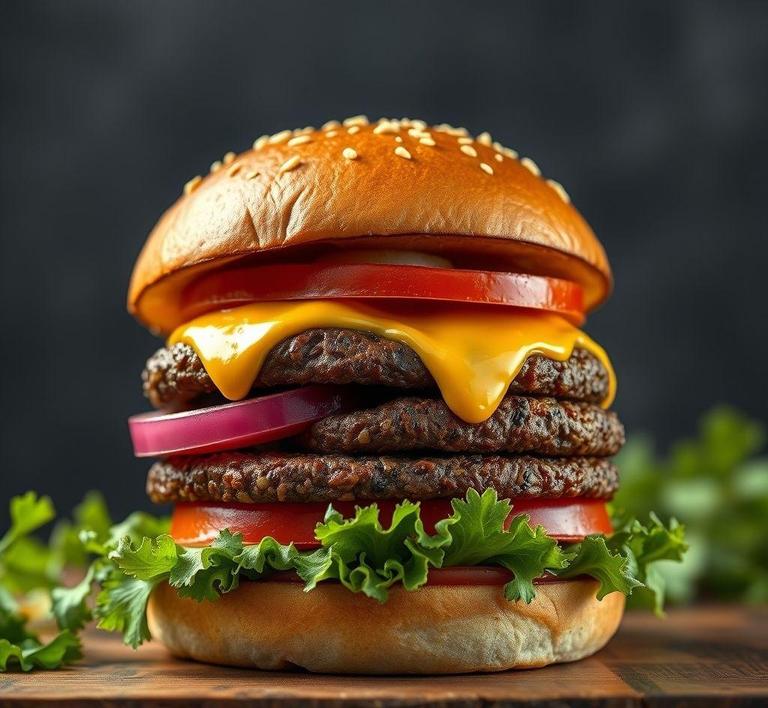When it comes to food storage, the question of whether or not you can refreeze burgers often comes up. Whether you’ve bought too many patties for a BBQ or just want to save some leftover cooked burgers, understanding the ins and outs of refreezing can help you avoid waste and keep your meals safe. While it’s possible to refreeze burgers, there are a few important things to keep in mind-like how they were stored before, whether they were cooked or raw, and how long they’ve been in the freezer. In this guide, we’ll walk you through everything you need to know about refreezing burgers, including tips for keeping them tasty and safe to eat.
Can You Refreeze Burgers?

The question of whether or not you can refreeze burgers is a common one, especially for those of us who end up with leftovers or buy in bulk. While it’s tempting to store everything back in the freezer for later, the safety and quality of your food depend on the handling of the burgers before and after freezing.
Refreezing Burgers: A Safety Consideration
The primary concern when it comes to refreezing burgers (or any meat, really) is the risk of bacterial growth. When meat is frozen, the growth of bacteria is slowed or halted. However, once you thaw it, bacteria can begin to multiply if not properly handled. If burgers are left out at room temperature for more than two hours (or one hour if it’s particularly hot), bacteria can grow rapidly, and refreezing them can lock in these harmful bacteria, leading to potential foodborne illness.
If you thaw burgers in the refrigerator, this is much less of a concern. Keeping meat below 40°F (4°C) prevents bacterial growth. Therefore, if the burgers have been thawed in the fridge and you haven’t left them sitting out for extended periods, they can be refrozen safely.
However, if they were thawed in the microwave or under hot water, the situation changes. In these cases, you should not refreeze them, as the outside of the burger may have reached unsafe temperatures, allowing bacteria to thrive.
How To Refreeze Burgers?
Refreezing burgers is not as simple as just tossing them back in the freezer after thawing. There are steps you should follow to maintain their safety and quality.
1. Thawing Properly
- If you plan to refreeze your burgers, ensure they are first thawed in the refrigerator, not on the countertop. The refrigerator method ensures that the burgers remain at a safe temperature throughout the thawing process.
- Avoid the microwave or hot water methods unless you plan to cook the burgers immediately. Rapid thawing causes parts of the meat to warm up too quickly, increasing the chances for bacteria growth.
2. Packaging Matters
- When refreezing burgers, it’s important to wrap them well to prevent freezer burn. Use plastic wrap, aluminum foil, or freezer-safe bags. For added protection, you can double-wrap the burgers-first in plastic wrap, then in aluminum foil or a freezer bag.
- It’s also helpful to divide the burgers into smaller portions or individual patties. This way, you only need to thaw the portion you intend to cook, and you avoid repeatedly thawing and refreezing the whole batch.
3. Label And Date
- Label the bags with the date of refreezing so that you can keep track of how long they’ve been in the freezer. Meat should ideally not be stored for more than 3-4 months if you’re refreezing it. After that, the texture and flavor may begin to deteriorate.
4. Freezing At The Right Temperature
- Set your freezer to 0°F (-18°C) or lower for optimal results. Anything above this temperature and you risk thawing the burgers partially or encouraging bacterial growth.
Quality Impact Of Refreezing Burgers
While refreezing burgers might be safe under the right conditions, it can have a noticeable impact on the texture and flavor. Here’s how:
1. Texture Changes
- When you freeze meat, water inside the cells expands and forms ice crystals. These crystals can rupture the cell walls, leading to a loss of moisture when the meat is thawed. This makes the burgers more prone to becoming dry and crumbly when cooked.
- Refreezing exacerbates this issue. Each cycle of freezing and thawing leads to more ice crystal formation, which results in a more significant degradation of texture. By the time you refreeze and thaw a burger for the second time, it may end up tough and dry.
2. Flavor Deterioration
- While freezing does not drastically affect the flavor of fresh burgers, repeated freezing can cause some flavor loss. As meat ages in the freezer, oxidation can occur, leading to off-flavors. These changes are subtle at first but become more pronounced the longer the burgers are stored in the freezer.
- Additionally, if you do not properly seal the burgers, they may absorb odors from other foods in the freezer, affecting their taste.
3. Fat Content And Juiciness
- Burgers, particularly fatty ones, may lose some of their juiciness after being refrozen. The fat in the meat may separate or render differently during the cooking process, causing the patties to be less flavorful and moist.
In short, you can refreeze burgers, but it’s not always recommended if you want to maintain the best quality. The safety aspect depends largely on how the burgers were handled during the thawing process-keeping them in the refrigerator is key to avoiding harmful bacterial growth. If you’ve kept them at a safe temperature and wrapped them well, you can refreeze them for later use. However, don’t expect the same fresh quality as before. The texture will likely suffer, becoming drier and possibly crumbly, and there may be subtle changes in flavor.
If you plan to refreeze burgers, think of it more as a backup option rather than a long-term solution. By taking the necessary precautions to store, thaw, and repackage properly, you can avoid food safety issues and minimize the negative impact on taste and texture.
Is It Safe To Refreeze Burgers?
Refreezing burgers, like any other meat or food item, raises a significant concern: food safety. Technically speaking, it is possible to refreeze burgers, but the process comes with important considerations. The core issue lies in how the burgers are handled before and during freezing and thawing.
When you freeze raw or cooked burgers, the temperature drop stops bacteria from multiplying. However, the second thawing and refreezing process can be problematic. When you thaw burgers, bacteria that may have been dormant in the freezing process begin to become active. If the burgers are refrozen before they’re cooked or before they’ve reached a safe temperature, this gives the bacteria a chance to multiply, increasing the risk of foodborne illness.
That said, refreezing cooked burgers is usually safer than raw ones. Once the burgers are cooked, the internal temperature will have reached a point that kills harmful bacteria, so the main concern is maintaining proper handling and storage. However, if you’re planning on refreezing burgers, it’s important that you follow specific steps to mitigate any risks and ensure the burgers are properly frozen and stored.
Signs That Burgers Should Not Be Refrozen
Refreezing burgers can lead to food safety issues, but there are also physical signs that indicate the burgers should never be refrozen. Here are some key red flags:
- Foul or Off Odor: One of the most obvious signs is when the burgers smell bad, sour, or rancid. Any unusual odor indicates that the burgers have started to spoil. This can happen if they were not handled or stored correctly, or if they’ve been thawed for too long. If you notice this, do not attempt to refreeze or eat the burgers.
- Change in Texture: Once frozen and thawed, burgers may experience a change in texture. If the burgers feel slimy, mushy, or sticky to the touch, it’s likely that bacteria have started to grow. This is especially true for raw burgers, where excess moisture can accumulate. The texture will degrade with each cycle of freezing and thawing, and once it’s beyond repair, it’s time to discard the burgers.
- Discoloration: A noticeable color change (from pink to brown or gray) in the meat is a sign that it’s not safe to refreeze. While some color change can be natural due to the freezing process, drastic changes may indicate that the meat has been compromised, either by bacteria or improper freezing methods.
- Freezer Burn: Freezer burn occurs when the meat is exposed to air in the freezer. You’ll know it by the appearance of dry, grayish spots on the burgers. While freezer-burned meat isn’t necessarily dangerous, it will have a significant impact on flavor and texture. Burgers with heavy freezer burn are likely best discarded instead of refrozen.
- Thawed Too Long: If the burgers were left out too long during the thawing process, especially at room temperature, bacteria can rapidly multiply. According to food safety guidelines, meat should not be left out at room temperature for more than two hours. If the burgers have been thawed improperly, they should be discarded.
Common Refreezing Mistakes
While refreezing can be done safely under the right conditions, there are a few common mistakes that many people make. These errors can lead to poor taste, texture degradation, and potential food safety hazards.
- Thawing and Refreezing Multiple Times: One of the biggest mistakes is repeatedly thawing and refreezing burgers (or any food, for that matter). Every time the burgers are exposed to heat and then refrozen, bacteria get a chance to grow, and the quality of the meat deteriorates. Ideally, once burgers are thawed, they should be cooked before refreezing if you plan to do so.
- Improper Storage: Many people make the mistake of not properly wrapping burgers before freezing them. If the meat isn’t wrapped tightly in plastic wrap, aluminum foil, or an airtight container, moisture from the air can cause freezer burn. This also allows bacteria and other microorganisms to thrive in the gaps where air can reach the meat.
- Refreezing Without Cooking First: Refreezing raw burgers is more risky than cooked ones because bacteria on the meat have the chance to multiply when thawed and then refrozen. Always cook the burgers thoroughly before refreezing, especially if they were previously frozen raw.
- Not Monitoring Freezer Temperature: One common mistake is not ensuring the freezer is set to the correct temperature, which should be at or below 0°F (-18°C). A fluctuating temperature can cause partial thawing, which opens the door for bacteria to grow, making the food unsafe to eat after refreezing.
- Refreezing Thawed Burgers Without Cooking: While it’s perfectly fine to refreeze cooked burgers, raw ones that have been thawed need to be cooked before being refrozen. Refreezing them raw can result in unsafe bacteria levels and a major texture change.
Tips And Tricks
If you find yourself in a situation where you need to refreeze burgers, there are a few strategies you can use to help keep them as safe and fresh as possible:
- Cook First, Refreeze Later: As mentioned earlier, cooking the burgers before refreezing them is always the safest option. This will kill any harmful bacteria that might be present on the meat. Make sure they are cooked thoroughly, reaching an internal temperature of at least 160°F (71°C).
- Use the Right Storage: When refreezing cooked burgers, wrap them tightly in foil or plastic wrap to minimize exposure to air. Place them in an airtight container or freezer-safe bag to keep out moisture. This reduces the chances of freezer burn and helps preserve their quality.
- Label and Date: If you plan on keeping the refrozen burgers for an extended period, label the packaging with the date it was cooked or refrozen. This way, you won’t forget how long it’s been in the freezer. Try to use refrozen burgers within 3-4 months for the best flavor and texture.
- Thaw Safely: When you’re ready to use the refrozen burgers, always thaw them in the refrigerator, not on the counter. This reduces the risk of bacteria growth. Never thaw burgers at room temperature, as the outer layer of the meat can reach dangerous temperatures while the inside remains frozen.
- Reheat Properly: Reheat burgers to an internal temperature of 165°F (74°C) to ensure they’re safe to eat. If you’re reheating in a microwave, be sure to stir or flip them halfway through to make sure they heat evenly.
Conclusion
Refreezing burgers is safe under the right conditions, but it’s crucial to approach it carefully. The most important aspect is how the burgers are handled before, during, and after freezing. If you take precautions, such as cooking burgers before refreezing, storing them properly, and avoiding repeated thawing and refreezing cycles, you can safely preserve your burgers for future meals.
However, if you notice signs of spoilage like off smells, discoloration, or freezer burn, it’s best to avoid refreezing and discard the burgers to avoid any health risks. By being aware of common mistakes and following the tips for proper storage and handling, you can enjoy your frozen burgers without compromising on safety or taste.


